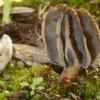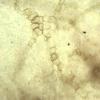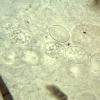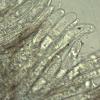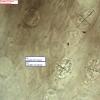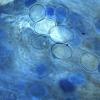
21-12-2025 21:32
Pol DebaenstHello, Garden, Burgweg 19, Veurne, BelgiumOn 10/1

21-12-2025 21:40
Isabelle CharissouBonjour, j'aimerais connaitre les références de

21-12-2025 21:31
Pol DebaenstHello, Garden, Burgweg 19, Veurne, BelgiumOn 10/1

21-12-2025 21:31
Pol DebaenstHello, Garden, Burgweg 19, Veurne, BelgiumOn 10/1

20-12-2025 23:08
Patrice TANCHAUDBonsoir, récolte sur sol sablonneux dans l'arri�

21-12-2025 09:32
Hello.A tiny ascomycete found embedded in wood in

20-12-2025 15:47
Mirek GrycHi.These grew on pine wood that was heavily covere

I found only one ascoma - on February, the 27th. Findplace: Portugal, Algarve, n. Loule, nature reserve Fonte Benemola, under Fraxinus angustifolia - and: Nerium oleander!
I first thought of M. anatolica because of the macroscopy. But unfortunately the specimen was not ripe, I found not asci with spores (first two fotos). So I dried half of the carpophore at once and kept the other half in a box. I investigated the nearly fluid rest at March, the 14th. I had luck and found some asci with spores (other fotos).
Compared with the original description from Turkey (Isiloglu et al. 2010) I came to the conclusion that my specimen cannot be M. anatolica: the spore measures do not fit perfectly and - more important - I could not find the ornament of striae described by the authors. But - ... possibly this was because of the ripening process that was "suboptimal" (???).
Yesterday (because of the post of Pierre-Arthur) I read the key of Clovez & al. 2015). Here there is no alternative to M. anatolica - and: Nerium oleander is considered as the partner plant of M. anatolica. And Nerium oleander was present in my collection (beneath Fraxinus angustifolia what I thought to be the partner or host).
So - can somebody help me with my morel? By the way: it is the onyl morel carpophore that I ever found in Portugal ...
Best regards from Lothar

Best wishes, Pierre-Arthur

Hello Hans and Pierre-Arthur,
thank you very much for your comments.
@Pierre-Arthur: I will try to look in Melzer - but unfortunately I am moving in the moment and every specimens are somewhere in boxes .... -
In cotton blue I could observe no structures of the spore wall.
Best regards from Lothar

Hi Pierre-Arthur,
I forgot to ask:
You write it is the first find of M. anatolica in Portugal. Well, it is not so difficult to find a lot of new species for Portugal, I fear. But - do you know something of Spanish finds? Or asked in another way: where besides Turkey exist reliable specimens of M. anatolica?
Thanks in advance and best regards from Lothar


